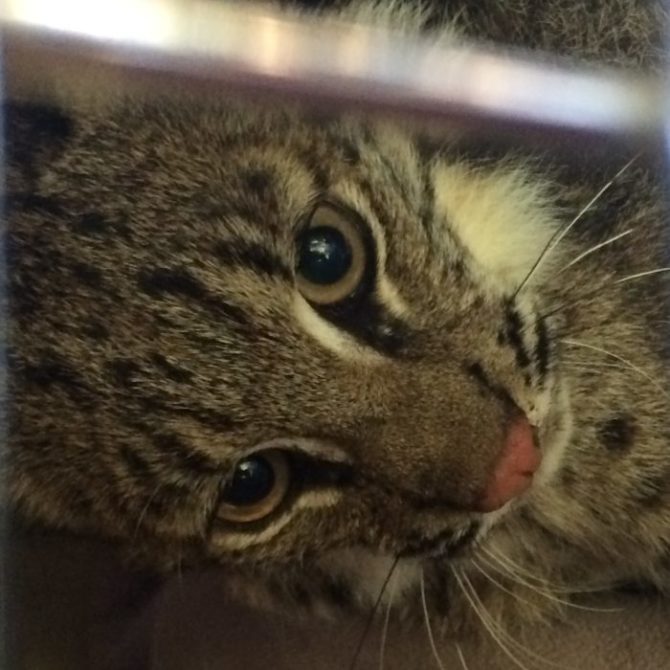Why Cub Petting Violates the Endangered Species Act
Tigers are listed as endangered pursuant to the implementing regulations of the ESA. See 50 C.F.R. § 17.11, and the ESA prohibits the “sell or offer for sale in interstate or foreign commerce any protected species,” and also makes it unlawful to deliver, receive, carry, transport, or ship in interstate or foreign commerce, by any means whatsoever and in the course of a commercial activity, any such species,” 16 U.S.C. § 1538(a)(1)(E).
Any white tiger or generic tiger (a tiger who is not registered in the studbooks and part of the tiger Species Survival Plan (SSP)) would not be a tiger who could serve any conservation purpose. Under current law it would appear that a permit to move such tigers across state lines, or use them for commercial purposes, such as paying to pet or pose with them, should be required. None of the cubs who are used this way could be properly permitted because they can not enhance the survival of species in the wild. 16 U.S.C. § 1538(a)(1)(E).
The Endangered Species Act (ESA) establishes a national policy “that all Federal departments and agencies shall seek to conserve endangered species and threatened species and shall utilize their authorities in furtherance of the purposes of [the Act].” 16 U.S.C. § 1531(c).
The ESA prohibits persons from taking endangered species. The ESA defines the term “take” to include “harass, harm, . . . wound, kill, . . . or to attempt to engage in any such conduct.” 16 U.S.C. § 1532(19).
“Harass” is defined by regulation as “an intentional or negligent act or omission which creates the likelihood of injury to wildlife by annoying it to such an extent as to significantly disrupt normal behavioral patterns which include, but are not limited to, breeding, feeding, or sheltering.” 50 C.F.R. § 17.3.
Breeding tigers and then taking their cubs away shortly after birth harasses both the mother tiger and the cubs. Using the cubs for long lines of paying customers to bounce, hold, drop and pose is obviously annoying to the cubs who scream and squirm to break free. Forcing the cubs to be bottle fed a non natural formula, instead of being allowed to suckle from their mothers disrupts normal behaviors and harms the cubs due to the inadequate nutrition and frequent aspiration pneumonia.
Section 10 of the ESA gives the U.S. Fish and Wildlife Service (FWS) limited authority to issue permits to allow otherwise prohibited activities like “takes,” transport, shipment, and sale only “for scientific purposes or to enhance the propagation or survival of the affected species.” 16 U.S.C. § 1539(a)(1)(a)
FWS regulations provide an exemption from § 10’s prohibitions for foreign species that are captive-bred in the U.S. if the “purpose” of taking, transporting, shipping, or selling the captive-bred species “is to enhance the propagation or survival of the affected species.” 50 C.F.R. § 17.21(g)(ii) Persons who seek to engage in any of these activities must apply for, and obtain, a captive-bred wildlife permit (CBW).
FWS, Proposed Rule, U.S. Captive-Bred Inter-Subspecific Crossed or Generic Tigers, 76 Fed. Reg. 162 (Aug. 22, 2011) states:
“We do not believe that breeding inter-subspecific crossed or generic tigers provides a conservation benefit for the long-term survival of the species. Inter-subspecific tiger crosses and animals of unknown subspecies cannot be used for maintaining genetic viability and distinctness of specific tiger subspecies. Generic tigers are of unknown genetic origin and are typically not maintained in a manner to ensure that inbreeding or other inappropriate matings of animals do not occur.”
None of the backyard breeders who allow cub petting are part of the Species Survival Plans administered by the American Zoological Association. None of the tigers or lions used in pay to play schemes at fairs, malls, parking lots or road side zoos are pure bred. None of the breeding that is done to produce these cubs is done for conservation, as defined by the USFWS.
Dr. Ronald L. Tilson—who served as Coordinator of the AZA’s Tiger SSP for tigers for 19 years and who is now Senior Conservation Advisor to the Minnesota Zoo Foundation—and Philip Nyhus—an Associate Professor of Environmental Studies with particular interest and expertise in tiger conservation who has published extensively in the area—explain, the vast majority of captive-bred tigers in the United States are generic; “They are no longer Amur or Sumatran or Bengal tigers. They are tiger soup,” and thus breeding these animals serves no conservation purpose. Philip J. Nyhus et al., Thirteen Thousand and Counting: How the Growing Captive Tiger Populations Threaten Wild Tigers, in Tigers of the World, 2d ed., pp. 236 (2010).
Dr. Steve Olson, Vice President of Federal Relations for the AZA, concurs: “To our knowledge, there are no captive tigers in the U.S. that are purebred subspecies with known pedigrees traceable to their wild-caught founders other than those managed within the AZA Tiger SSP.” See Letter to Tim Van Norman, Chief, Branch of Permits, Division of Management Authority (“DMA”), FWS, from Steve Olson, AZA (Aug. 30, 2011).
As Jack Woody, who oversaw the endangered species program at the FWS for over twenty years, summarized: “It’s useless to produce truckloads of animals if there’s nowhere to release them.” Laura Tangley, Captive Propagation: Will It Succeed?, 121 Science News 266, 268 (1982)
CBW registration may be issued only “when the applicant documents that his activities will serve to enhance propagation or survival of endangered species . . . and the principal purpose of the activities is captive breeding for conservation purposes.” FWS, Captive-Bred Wildlife Registration under the Endangered Species Act 2 (Jan. 2012).
The “original intent” of the CBW system was “the encouragement of responsible breeding that is specifically designed to help conserve the species involved.” Captive-Bred Wildlife Regulation, 63 Fed. Reg. 48634, 48635 (Sept. 11, 1998).
The CBW regulations provide that “public education activities may not be the sole basis to justify issuance of a registration.” 50 C.F.R. § 17.21(g)(3); see also FWS, Captive-Bred Wildlife Registration under the U.S. Endangered Species Act (“Please note that registrations are not issued for conservation education only.”).
When the agency amended the CBW regulations to codify this policy in 1993, it voiced concern that, in the absence of such limitation, “captive-bred animals . . . might be used for purposes that do not contribute to conservation, such as . . . for entertainment.” Captive-Bred Wildlife Regulation, 57 Fed. Reg. 548-01, 550 (Jan. 7, 1992).
In the preamble to the final rule, the agency explained that it has “sincere doubts about the relative conservation benefits that are provided to non-native species in the wild from the public exhibition of living wildlife.” Captive-Bred Wildlife Regulation, 58 Fed. Reg. 68323, 68324 (Dec. 27, 1993)
The scientific community concurs that using endangered species in exhibitions and entertainment has no impact on public attitudes about conservation. For example:
1. In 2001, the AZA set out to measure the impact of zoo visits on visitors’ “conservation-related knowledge, attitude, affect and behavior.” Lynn D. Dierking, Visitor Learning in Zoos and Aquariums: Executive Summary, AZA, at i (2001-2002). The study concluded that claims that zoos might have the potential to impact positively guests’ conservation knowledge, affect and behavior, “were not substantiated or validated by actual research.”
2. A survey at Rosamond Gifford Zoo reported in AZA’s Communiqué in 2003 by the zoo’s then-president, Dr. Anne Baker, showed that the zoo’s guests were not looking for a serious educational experience. Instead, the public reported overwhelmingly that a visit to the zoo meant quality time with family members and fun. Lisa Kane, Contemporary Zoo Elephant Management: Captive to a 19th Century Mission, in An Elephant in the Room: The Science and Well-Being of Elephants in Captivity 87, 94 (Debra L. Forthman et al. eds., 2009) (citing Anne Baker, From the President, 3 COMMUNIQUÉ (Dec. 2003)).
3. In 2006, a comprehensive study was conducted at five UK zoos aimed at directly measuring the educational impact of a zoo visit. Visitors were asked questions before and after a visit to assess their (1) conservation knowledge; (2) commitment to conservation; and (3) capacity to get involved. No statistically significant changes were measured across the five sites, with the exception of one zoo in which visitors seemed to have a heightened awareness of how they might contribute to conservation. This anomaly was later thought to be an artifact of visitors being in a hurry to enter and therefore being less accurate in their first round of answers than they would have been otherwise, so that it appeared that their knowledge improved after the visit more than it had. Royal Society for the Prevention of Cruelty to Animals, The Welfare State: Measuring Animal Welfare In The UK 2006, at 95-96 (2006).
4. Another study conducted at Lincoln Park Zoo’s gorilla and chimpanzee exhibits showed that frequent exhibit visitors were no more knowledgeable than first-time visitors and found, no change in attitudes about gorillas or chimpanzees. This lack of improved attitude was absent whether zoo guests were first-time or frequent visitors. K. E. Lukas & S. R. Ross, Zoo Visitor Knowledge and Attitudes Gorillas and Chimpanzees, 36 Journal of Environmental Education 33, 33-34, 41, 46-47 (2005).
5. In terms of affecting zoo guest action, a study at Brookfield Zoo failed to detect a significant effect on visitors’ intent to get involved in conservation even after multiple visits to an exhibit called The Swamp. Carol D. Saunders & H. Elizabeth Stuart Perry, Summative Evaluation of the Swamp: a Conservation Exhibit with a Big Idea, XII Visitor Behavior 4, 5-6 (1997).
6. Zoo Atlanta investigated whether its interactive elephant exhibit encouraged active support for elephant conservation. Visitors leaving the zoo were asked to take an already stamped postcard and send it to the White House expressing their views on whether or not the United States should continue its moratorium on the ivory trade. Only 5.9 percent of those who saw the zoo’s elephant show and experienced the interactive elephant display at the zoo mailed the cards. Zoo visitors who saw neither returned the cards at a rate of 3.8 percent. Jeffrey S. Swanagan, Factors Influencing Zoo Visitors’ Conservation Attitudes and Behavior, 31 Journal of Environmental Education 26, 26-30 (2000).
7. A study of visitors to Monterey Bay Aquarium found that any improved commitment to conservation amongst visitors this had disappeared several months after their visit to the facility. L. Adelman et al., Impact of National Aquarium in Baltimore on Visitors’ Conservation Attitudes, Behavior, and Knowledge, 43 Curator 33-61 (2000).
By exhibiting captive-bred tigers for purposes of entertaining the public these backyard breeders are doing more harm than good. It is actually detrimental to the species because of the serious mis-understanding it gives the public about the status of the species. As Nyhus et al. explain:
“Zoos may actually undermine the continued existence of what they purport to celebrate. People watch the films, they visit the zoos, and by the mesmeric power of these vicarious experiences, they come carelessly to believe that the Bengal tiger . . . is alive and well because they have seen it.”
Philip J. Nyhus et al., Thirteen Thousand and Counting: How the Growing Captive Tiger Populations Threaten Wild Tigers, in Tigers of the World, 2d ed., pp. 237 (2010); see also id. at 232 (our exposure to tigers as sources of entertainment has led to “the blurring of our awareness of what tigers are and the serious threats wild tigers face to their continued survival”).
This is especially true with regard to the animals bred for use as photo props, to be petted, posed with and sometimes even used in “swim with tigers” schemes—who are often white tigers—that do not even exist in the wild. Experts agree that people who spend money to see white tigers on exhibit are “actually less—not more—likely to have a meaningful understanding of the real challenges of wild tiger conservation.” Id. at 237-38.
Nyhus et al. explain, “One logical outcome of the popularity of white tigers is a warped perspective and awareness of what a tiger is and the true threats faced by wild tigers.” Id. at 234-35.
Paying to interact with captive tigers is detrimental to the species because it diverts scarce resources from conservation efforts that could have a truly beneficial impact on endangered animals in the wild. Snyder et al. state that they “have frequently dealt with funding competition between [“in the wild efforts” and “captive breeding”] and are acutely aware of how one approach often preempts the other, sometimes to the detriment of crucial in situ needs.” Noel F.R. Snyder et al., Limitations of Captive Breeding in Endangered Species Recovery, 10 Conservation Biology 338, 344 (1996); see also Andrew E. Bowkett, Recent Captive-Breeding Proposals and the Return of the Ark Concept to Global Species Conservation, 23 Conservation Biology 773, 774 (2009) (reviewing the literature); IUCN, The Ethiopian Wolf: Status Survey and Conservation Action Plan 65 (2002).
Please support the BigCatBan.com
Research composed from Comments of People for the Ethical Treatment of Animals in Opposition to PRT-05161B July 2013.







